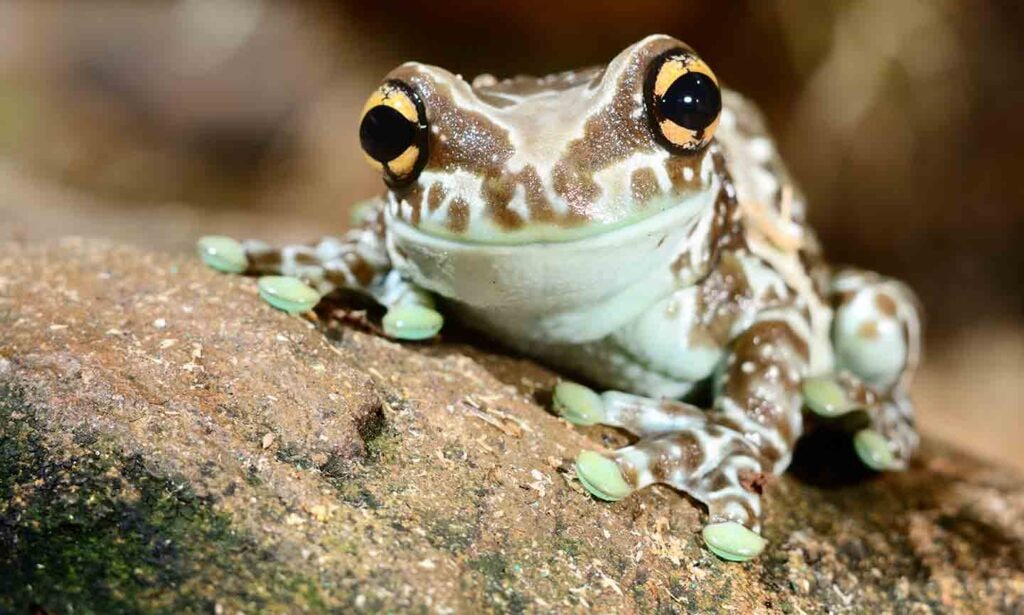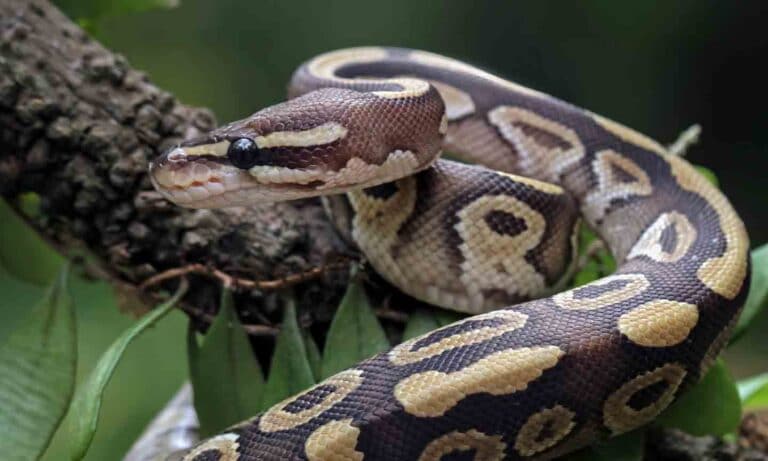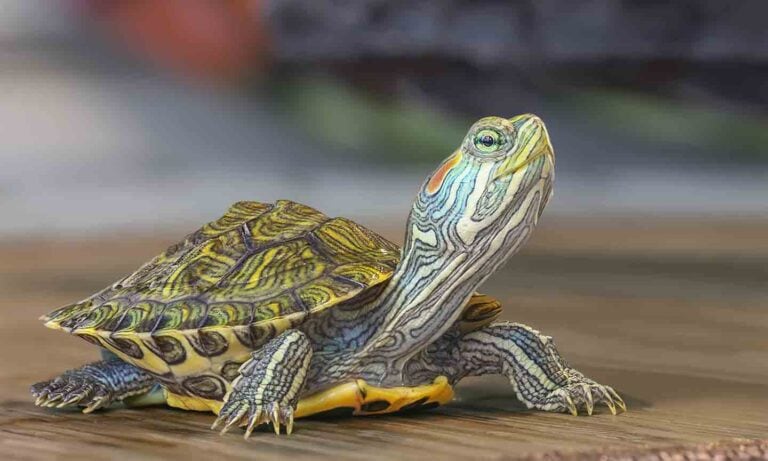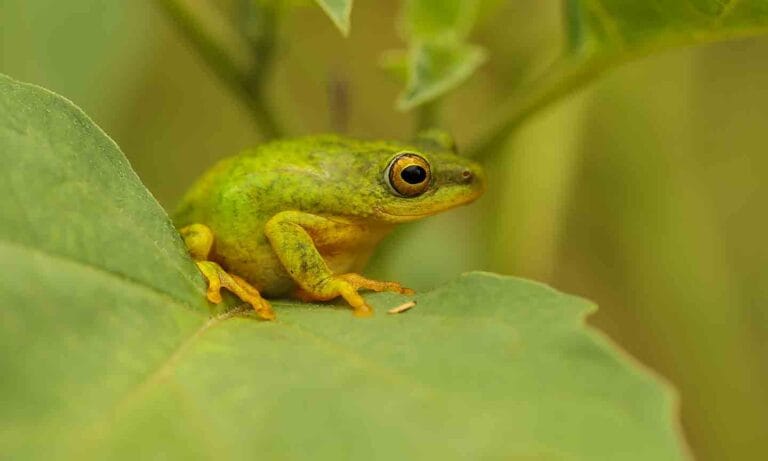The Basics
- Scientific name: Frogs are classified in the order Anura.
- Range of sizes: From 0.3 to 12.5 inches
- Lifespan: Up to 20 years
Fast Facts
- Frogs use their eyeballs to help swallow food by pulling them into their skull. In fact, most frogs can’t swallow with their eyes open.
- They can take in water and oxygen through their skin.
- Some species of frogs can leap up to 20 times their body length in a single jump.
- Frogs are known for their diverse range of calls and vocalizations. Each species has its own distinct sound, which they use for communication, mating and territorial defense.
Terrestrial Frog Care Supply Checklist
Everything you need for frogs who primarily spend their time on land.
- Tank or enclosure with lid
- Bedding or substrate
- Heat source, such as a heat bulb or ceramic heat emitter
- UVB light
- Water source, one that’s large enough for them to soak in
- Tap water conditioner to make dechlorinated water
- Spray bottle or automated misting system to keep humidity high
- Hygrometer
- Thermometer
- Hideouts
- Frog-safe cleaner
- Frog food (varies by species)
- Calcium supplement
- Multivitamin
- Food-handling tweezers or tongs
- Food dish
- Water dish
Aquatic Frog Care Supply Checklist
Everything you need for frogs who primarily swim in water.
- Fully aquatic enclosure, such as an aquarium
- Aquarium filter, appropriately sized for the tank
- Smooth river rocks, none of which should be small enough for the frog to swallow
- Water quality testing kit
- Tap water conditioner to make dechlorinated water
- Heat source, such as a heat bulb or ceramic heat emitter
- UVB light
- Hygrometer
- Thermometer
- Hideouts
- Frog-safe cleaner
- Frog food (varies by species)
- Calcium supplement
- Multivitamin
- Food-handling tweezers or tongs
- Food dish
- Water dish

Habitat
Setting up a home for your new frog is an exciting project! Since this is where they’ll spend most of their time—living, playing and eating—it’s important to make sure they have everything they need and feel comfortable.
Enclosure
There are several different types of habitats for frogs, each with its own benefits for different species.
Glass Terrariums
In general, the most popular choice for housing pet frogs is a glass tank or aquarium, aka a terrarium, that includes a secure lid that can prevent escape. (Remember, these animals can jump!) They’re easy to clean and maintain, and provide clear visibility to see your frog. They also help maintain the humidity levels and temperatures frogs require.
Screen Enclosures
You can also consider a screen enclosure, which is ideal for species that require high ventilation, such as tree frogs. Rather than glass, the walls of this enclosure are made from a mesh material, which provides excellent airflow.
Paludariums
A paludarium is a hybrid enclosure that includes both land and water habitats, and is mainly used for semi-aquatic frog species. These are frogs who divide their time between hopping around on land and swimming in water.
Choosing the Right Size
The size requirements for frog enclosures vary depending on the species and the number of frogs being housed. As a general guideline, the enclosure should be large enough to accommodate the frog’s natural behaviors and movements.
Additionally, taller tanks are preferable for tree frogs to allow for climbing space, while terrestrial species may benefit from longer tanks with ample floor space.
The most important thing to consider when choosing an enclosure is the lifestyle of your frog. For example, ambush predators, such as Pac-Man Frogs, don’t actually move that much during the day, if at all. Instead, they sit still, buried in the dirt, waiting for prey to approach them. While you could build a large enclosure for them, they are unlikely to appreciate anything bigger than a 10-gallon tank.
If you’re unsure what size tank your frog needs, talk to your veterinarian.
Bedding
The type of bedding or substrate you need depends on your type of frog. For instance, aquatic frogs require a setup that’s similar to what you’d create for a fish. Aquatic frogs should not have gravel or sand at the bottom of the enclosure, since they are prone to swallowing anything that’s smaller than their mouth. Instead, large river rocks are a better choice.
Land frogs will benefit from an organic substrate, such as a clean soil mixture, coconut fiber, sphagnum moss or even just a wet paper towel. Talk to your vet or amphibian expert to find out the proper layering technique for your frog's substrate so that it doesn’t become overly saturated by water.
These materials help maintain humidity levels, provide a soft and stable surface for burrowing or hiding, and support the growth of live plants if desired.
The natural history of your frog’s species will provide the best information on what type of environment should be set up, so do your homework. You should create an enclosure that mimics the natural habitat of the frog species while also providing a comfortable, hygienic environment. As always, contact your vet with any questions.
A Heat Source
A heat lamp or heating pad can keep your frog at a comfortable temperature 24/7. Heat requirements vary by species, so ask your veterinarian about the ideal temperature for your pet.
You’ll also need:
- A thermometer: to keep an eye on the enclosure’s temperature
- A hygrometer: for checking the humidity level in the tank to ensure it’s appropriate for your frog. (Again, if you don’t know your frog’s ideal humidity level, ask your veterinarian.)
UV Light
Some frogs require UVB lighting to synthesize vitamin D3.
A Lid and/or Locks
Many enclosures have locks or doors to prevent escape, but you’ll still need to pay close attention to make sure your frog doesn’t hop out of their habitat. Start by ensuring that the enclosure has a secure lid that fits tightly to prevent gaps or openings. Use clips or locks to secure the lid in place, especially if the frog is known to be particularly agile or curious. Regularly inspect the enclosure for any wear or damage to the lid or walls that could create potential escape routes, and promptly repair or replace any compromised areas.
Decor
It’s important that frogs have places to hide within their enclosure, also known as hideouts. In these spots, frogs can retreat and feel secure, something that mimics their natural habitat and reduces stress.
These can include things like:
- Resin dens
- Hollow logs
- Coconut shells
- PVC pieces the frog can fit into
- Non-toxic live plants
- Artificial plants
Also, depending on the species, some frogs may benefit from climbing materials like branches, vines or driftwood. These add enrichment and allow for natural behaviors.
Adding leaf litter, moss and other natural materials can further enhance the aesthetic of the enclosure and provide additional hiding spots.
Cleaning and Upkeep
Regularly cleaning your frog’s enclosure is essential for maintaining a healthy and hygienic environment. It’s best to spot-clean the enclosure daily, removing any uneaten food and waste. At the very minimum, you should spot-clean weekly. Remove soiled substrate and replace it with fresh substrate as needed.
To make things easier, always keep cleaning supplies on hand for regular tank maintenance, including a siphon for spot-cleaning, a scrub brush for cleaning the tank walls and non-toxic disinfectants for deep cleaning. Also, wash water dishes and other accessories with mild non-toxic soap and water often to prevent bacterial growth.
Deep cleaning of the entire enclosure should be done regularly, typically every two to four weeks. This involves removing all decor, substrate and accessories from the enclosure, cleaning them thoroughly with a frog-safe disinfectant and rinsing them well before returning them to the enclosure. Wipe down the walls and floor of the enclosure with a frog-safe disinfectant, then add fresh substrate if indicated and replace the decor and accessories.
It’s super important to fully rinse off all surfaces with water prior to returning the frog to the tank, even if you have been using frog-safe disinfectant.
Regular maintenance also involves monitoring equipment such as heating and lighting fixtures to ensure they are functioning properly. Trim plants as needed to maintain the enclosure’s aesthetics and functionality.
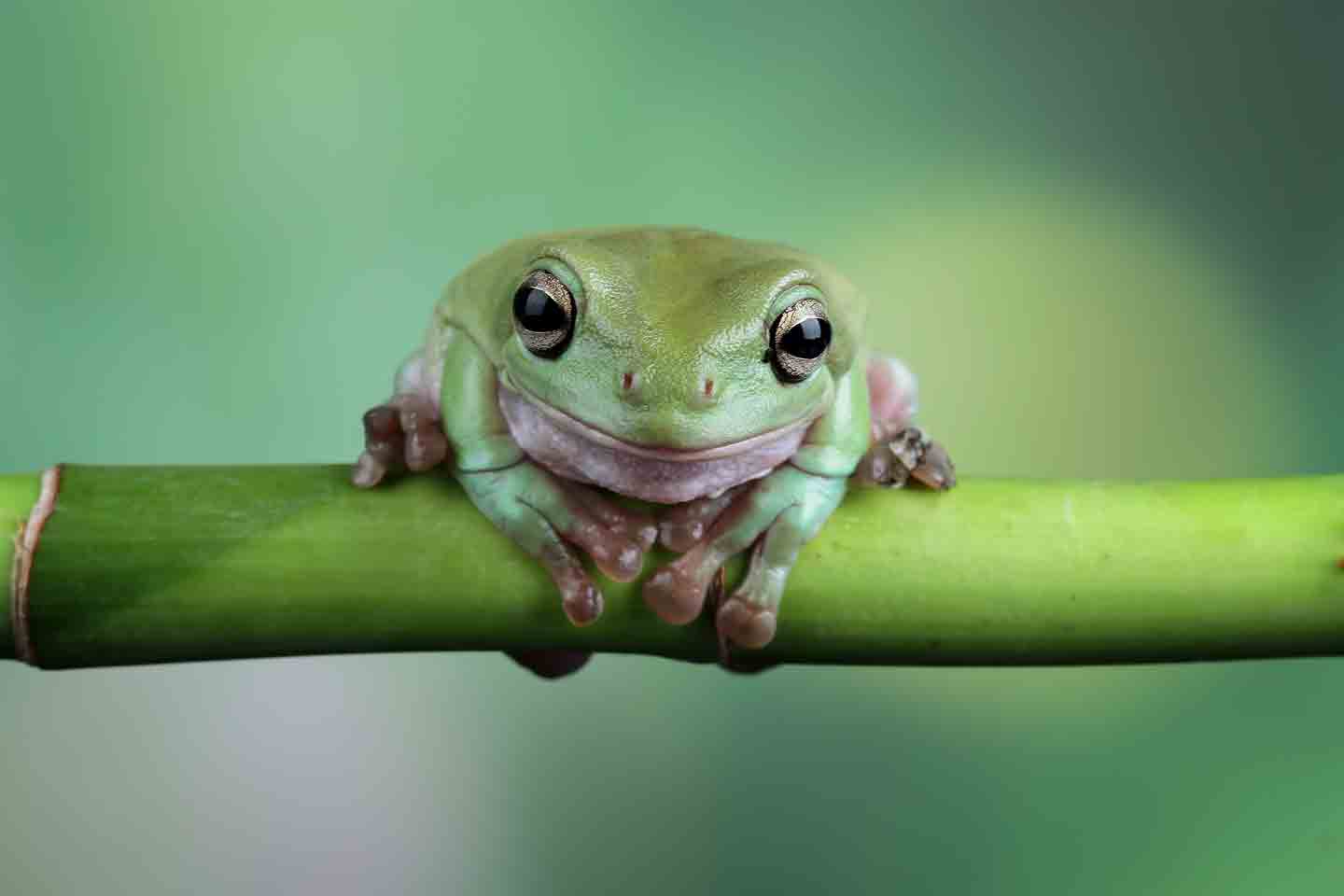
What Do Frogs Eat?
Frog Food
Frogs are primarily carnivorous, feeding on insects and other small invertebrates.
Terrestrial frogs feed on a diet of bugs of various sizes, including live insects, small invertebrates like worms and, occasionally, small vertebrates such as fish or tadpoles. Commonly fed insects include:
- Crickets
- Mealworms
- Waxworms
- Fruit flies
Aquatic frogs in captivity are fed things like:
- Specially made frog pellets
- Bloodworms
- Brine shrimp
For all types of frogs, providing a varied diet helps ensure nutritional balance and prevent boredom.
Frog Vitamins and Supplements
Frogs also need a plain calcium supplement (without vitamin D3) dusted on their food three times weekly, along with a multivitamin powder once weekly. These supplements can prevent nutritional deficiencies and promote overall health.
Some frog species may also benefit from occasional supplementation with vitamin D3 or other specialized supplements, depending on their specific dietary and environmental needs. Always research the dietary requirements of your frog’s species and consult with a veterinarian for personalized feeding recommendations.
Frog Feeding Supplies
Be sure to stock up on feeding supplies. You’ll need:
- Tweezers or tongs for handling live insects
- A small dish for offering food.
How Often To Feed Your Frog
You’ll typically feed your frog daily when they’re young, and two to three times weekly as an adult—but the frequency of feeding depends on the frog’s species, age, size and individual appetite.
Be sure to monitor your frog’s body condition and adjust feeding frequency accordingly to prevent obesity or malnutrition. Offer an amount of food that your frog can consume within a few minutes, removing any uneaten prey items to prevent them from causing stress or fouling the enclosure. If you have concerns about your frog’s weight or diet, talk to your vet.
Water Requirements
Yes, your frog does need water to drink! The water in your frog’s enclosure—whether it’s in their water bowl, in their substrate, in their swimming areas or elsewhere—should be non-chlorinated. If you’re using tap water, you’ll need a water conditioner to remove chlorine and other harmful chemicals, making it safe for drinking and soaking.
Aquatic frogs are kept underwater, so they need a significant depth of water to maintain health. (Again, talk to your vet about how much water your frog needs.) They may also benefit from water features like waterfalls.
Poisonous/Toxic Foods for Frogs
Feeding your frog wild insects should be avoided, as they often contain pesticides that are toxic to frogs. Also, common household insects like fireflies are very toxic, so be sure to monitor your frog if they’re outside the enclosure.
Frogs are mostly carnivores, so for the most part, you won’t have to worry about toxic plants, but make sure anything you add to the cage is non-toxic to frogs, just in case.
The good news is that if you simply stick to commercially available foods, you’ll eliminate any worries around toxic food.
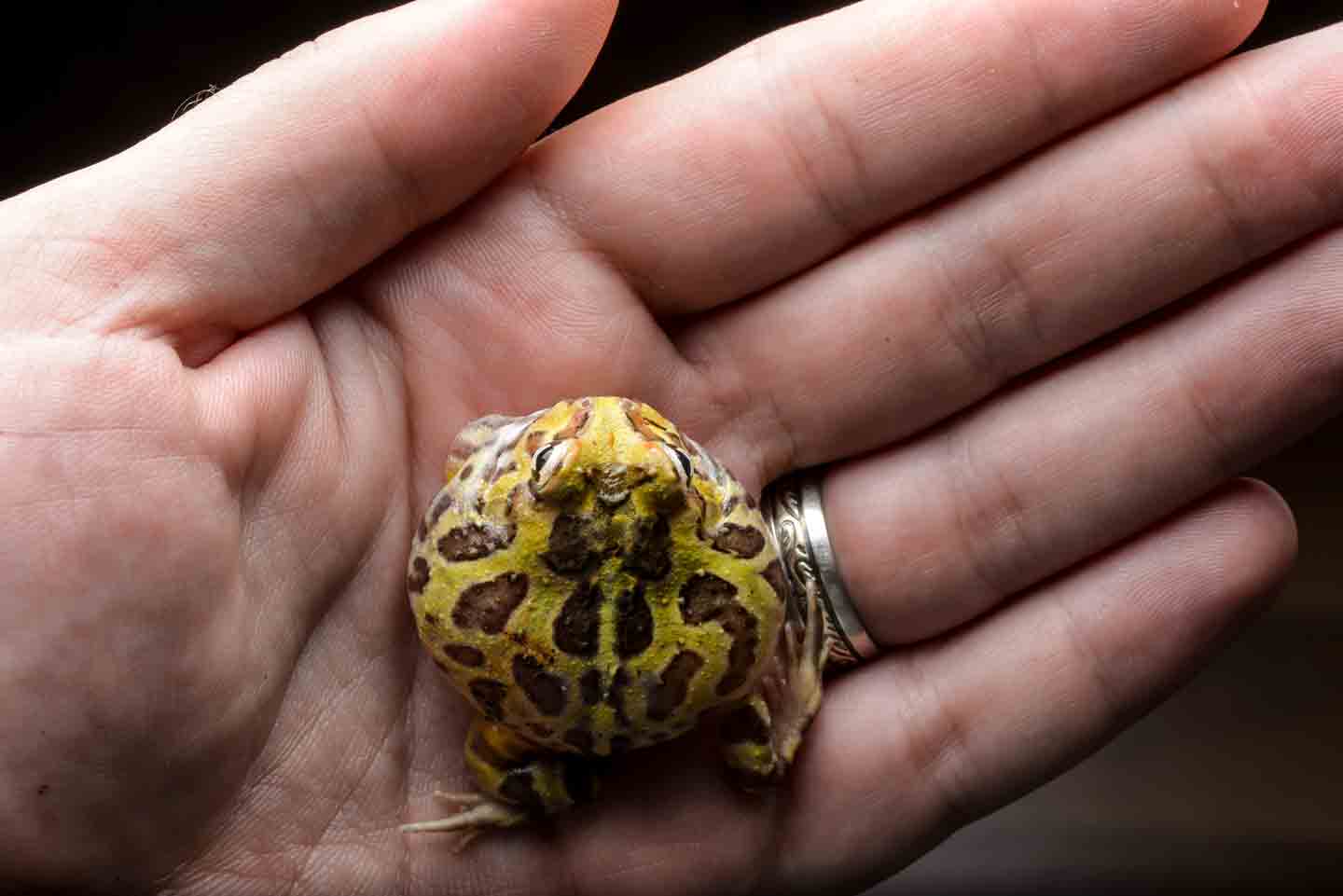
How To Handle a Frog
Handling a frog isn’t as straightforward as cuddling a puppy. With oils on our hands that can be harmful to their delicate skin and slime coat (a protective layer that helps regulate moisture and ward off infections), it’s crucial to be as careful as possible with frogs. As a general rule: You should never touch your frog directly unless absolutely necessary, such as if they unexpectedly jump out of their enclosure.
If you do intend to hold your pet frog, do your best to minimize stress and ensure both the frog’s safety and your own. Follow these tips:
- Before attempting to hold or touch the frog, always wash your hands thoroughly to remove any traces of chemicals or contaminants.
- Due to the risk of salmonella, it’s recommended to wear gloves. Use non-latex gloves that have been rinsed and moistened first—for this, you can use distilled, reverse-osmosis or dechlorinated tap water.
- Approach the frog calmly and gently, using slow and deliberate movements to avoid startling them.
- Support their body with both hands, keeping a secure but gentle grip to prevent them from jumping or escaping. Avoid squeezing or gripping the frog too tightly, as this can injure or stress them.
- If your frog shows signs of distress or discomfort, such as trying to escape or vocalizing, return them to their enclosure.
- Holding them close to the ground or another safe surface to land on is ideal—that way, if they do jump away, they have a gentle spot to land.
- Even if you wore gloves while handling the frog, wash your hands thoroughly with soap and water again after touching them or their enclosure, as well as any equipment used for feeding or cleaning.
- Avoid touching your face or eating while handling the frog to prevent the transmission of bacteria.
Health
Signs of a Healthy Pet Frog
Here are the signs of a healthy pet frog to look for:
- Bright, clear, open eyes
- Alertness and vitality
- Displaying natural behaviors, such as hopping, exploring their enclosure and hunting for food
- Smooth, moist, glossy skin
- Bright, shiny colors
- Jumping and moving actively when stimulated
- Healthy appetite
- Well-rounded body shape
- Regular bowel movements, with feces appearing firm and well-formed
- Regular shedding of skin
Common Health Problems
- Skin infections from unsanitary conditions or improper substrate
- Nutritional secondary hyperparathyroidism or metabolic bone disease, a common issue caused by poor calcium in the diet and lack of UVB exposure, which can result in broken bones and deformities
- Respiratory infections due to exposure to cold air or improper humidity levels
- Parasite infections, such as by nematodes or protozoa, leading to symptoms like weight loss, lethargy or gastrointestinal issues
- Stress-related conditions, including anorexia or behavioral changes, often stemming from inadequate habitat conditions or handling
- Obesity due to overfeeding
When To See Your Vet
It’s a good idea to have your new pet checked out by a qualified exotic animal veterinarian as soon as you take them home, to make sure they are healthy. After an initial visit, you should take them in for annual checkups. While blood work can be difficult to obtain in smaller frogs, yearly fecal testing and physical exams can help prevent illness. Also, an exotic veterinarian will work with you to make sure you’re meeting your frog’s specific needs at home.
Additionally, if you notice any signs or symptoms of illness, seek veterinary care promptly. These can include:
- Changes in appetite
- Lethargy
- Color change
- Unusual masses
- Weight loss
- Abnormal behavior
- Skin lesions
- Difficulty breathing
- Abnormal feces
Need help finding a vet near you? Try the “Find a Vet” feature at the Association of Reptilian and Amphibian Veterinarians (ARAV) website. If you’re part of a local amphibian group on social media, posting a question to the members about their vets may be beneficial as well.
Choosing a Pet Frog
Frogs aren’t typical pets, so consider these facts before bringing one home:
- Frogs aren’t cuddly and typically don’t love being handled.
- They are fragile due to their specialized skin, so daily maintenance is required to keep them misted and healthy.
- Frogs live a long time, often for over 10 or even 20 years, so you should be certain that you can provide long-term care for them.
Before getting a frog, be sure to research the specific species you are interested in to understand their natural habitat, dietary needs and environmental requirements. Additionally, assess your level of experience and commitment to caring for a pet frog, as some species may be more challenging to care for than others. Finally, consider the availability of veterinary care for exotic animals in your area, as it’s important to have access to professional medical assistance if needed.
Recommended pet frog species for beginners include:
- Australian Green Tree Frog (aka White’s Tree Frog or Dumpy Tree Frog)
- African Green Tree Frogs
- Pac-Man Frogs (South American Horned Frog)
FAQs About Keeping Frogs as Pets
Q:
Do frogs make good pets?
Q:
Do pet frogs like to be held?
Q:
Can I keep a frog I found as a pet?
All exotic pets require special care to be happy and healthy, frogs included. That’s why it’s essential to educate yourself on your potential pet frog’s needs. Learn how to set up a proper enclosure. Track down a qualified vet. Read up on the best diet for your frog. And decide if you can fit a frog into your lifestyle and care for them well.
Expert input for this story provided by: Dr. Melissa Giese, DVM, veterinarian at Chicago Exotics Animal Hospital in Chicago, Illinois; Dr. Sherri Edgar, DVM, Owner Veterinarian at CityVet Las Colinas in Irving, Texas; Jonah Marion, MLAS, DVM; and Laurie Hess, DVM, Diplomate ABVP (Avian Practice) at Veterinary Center for Birds & Exotics in Bedford Hills, New York.
Share:
